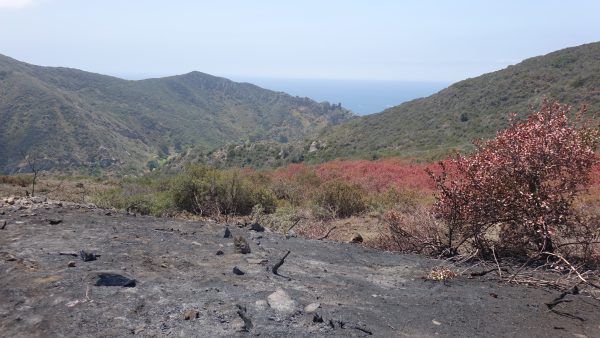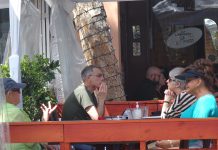
Under a mid-day sun, turkey vultures and crows were the only signs of life on a trail running along the edge of the Pacific Horizon biological preserve on Wednesday.
To the south, multimillion dollar views of the Pacific Ocean and pristine, albeit drought-choked, open space. Looking eastward toward Laguna Niguel the full scope of the Coastal Fire’s devastation came into focus.
The fire line is a twisted heap of vegetation plowed over by firefighting bulldozers. A 10-foot wide ribbon of fire retardant sticks to leaves as if they had been spray-painted pink. The earth and a few standing bushes inside the burn area are scorched black. This is where firefighters stopped the Coastal Fire’s advance toward the Balboa Avenue neighborhood.
The Orange County Transportation Authority is another victim of the Coastal Fire, which claimed about 32 acres of the 151-acre Pacific Horizon property the agency purchased in April 2015. The acquisition was intended to offset the impacts of freeway development elsewhere in the County.
County officials are still getting their arms around the extent of the damage. The first concern among emergency and land managers is whether burned hillsides are at risk of erosion or a debris flow during a major storm. Last December, canyon residents in the Bond Fire burn area were ordered to evacuate ahead of heavy rains that caused major debris flows.
“Restoration for the burn area is an exercise in patience—really it’s just wait and seem,” OCTA spokesperson Eric Carpenter said. “Those on staff who understand how restoration after a fire works say it’s best to give the land time to recover naturally as the native seeds are already in the soil.”
The Coastal Fire’s temperature could be a factor in habitat recovery time, Carpenter added. Biologists are generally concerned that when open spaces burn too frequently the resident plants’ rootstocks don’t have time to replenish between fires. Rainfall over the next several years will also be consequential in the restoration.
An OCTA contractor would be brought in to cut down non-native plants, including mustard. These invasive grasses crowd out native species and create prime conditions for future fires if they’re allowed to grow unchecked.
Laguna Canyon Foundation will be a partner in the recovery efforts throughout Aliso Canyon, officials said. The nonprofit has already been working to restore sections of Aliso Creek to their natural state for almost 15 years.
“We want to support the land managers in the most effective way possible and we’re committed to being a part of the restoration efforts and any community outreach to make sure the land heals,” said Hallie Jones, executive director of Laguna Canyon Foundation.
Pacific Horizon is home to big-leaved crownbeard, a plant listed by the federal government under the Endangered Species Act as rare and threatened. It also provides habitat for the federally listed California gnatcatcher and the state-protected rufous-crowned sparrow.
In 2010, the California Coastal Commission took action to permanently protect 75 acres of undeveloped land in the area known as the Hobo Aliso Ridge in South Laguna. A settlement with Driftwood Properties, LLC addressed the unpermitted clearance of several acres of rare habitat that’s also home to big-leaved crownbeard.
The Driftwood property is southwest of the Coastal Fire burn area and Pacific Horizon preserve according to an Orange County Fire Authority map. It’s not immediately clear if there were any spot fires within Hobo Canyon.
A 1992 biological assessment found Hobo Canyon is the most significant of South Laguna’s open spaces and is among the most biologically valuable open spaces in the entire city, according to the Sierra Club Angeles Chapter.
“If it can recover on its own, we would rather not bring plants or seeds in from other sources because this area is so special genetically,” Carpenter said.




